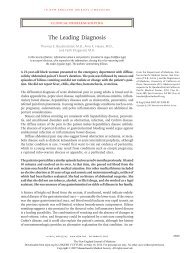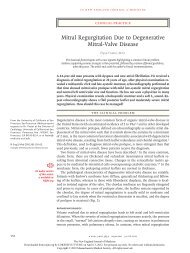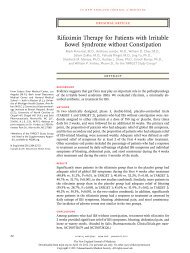Case Records of the Massachusetts General Hospital
Case Records of the Massachusetts General Hospital
Case Records of the Massachusetts General Hospital
You also want an ePaper? Increase the reach of your titles
YUMPU automatically turns print PDFs into web optimized ePapers that Google loves.
nosis was confirmed by <strong>the</strong> transmission <strong>of</strong> disease<br />
to primates have survived as long as 15 years. 10<br />
Distinctive clinicopathological variants <strong>of</strong> Creutzfeldt–Jakob<br />
disease include <strong>the</strong> Heidenhain variant<br />
(characterized by early cortical blindness and visual<br />
agnosia, with striking involvement <strong>of</strong> <strong>the</strong> occipital cortex),<br />
<strong>the</strong> Brownell–Oppenheimer variant (prominent<br />
ataxia, with severe cerebellar involvement and relatively<br />
little cognitive impairment), <strong>the</strong> Stern–Garcia<br />
variant (prominent involvement <strong>of</strong> <strong>the</strong> basal ganglia<br />
and thalamus), <strong>the</strong> panencephalitic variant (disproportionate<br />
involvement <strong>of</strong> white matter in Japanese patients),<br />
and a poliodystrophic form. 20 These clinical<br />
descriptions will continue to be useful in recognizing<br />
<strong>the</strong> many presentations <strong>of</strong> Creutzfeldt–Jakob disease,<br />
but <strong>the</strong>re is no doubt that <strong>the</strong> disease is rapidly<br />
being redefined on a genetic basis.<br />
Cerebellar dysfunction, as seen in this case, is relatively<br />
common in Creutzfeldt–Jakob disease. Ataxia<br />
is present initially in approximately a third <strong>of</strong> patients<br />
and develops eventually in up to two thirds. 20 The<br />
basal ganglia are involved in over half <strong>the</strong> patients,<br />
but involuntary movements typically decrease as <strong>the</strong><br />
disease runs its course. 20 Myoclonus eventually appears<br />
in up to 84 percent <strong>of</strong> patients. 20 A dramatic<br />
startle reflex is <strong>of</strong>ten demonstrated at <strong>the</strong> bedside, but<br />
it is by no means a constant feature <strong>of</strong> <strong>the</strong> disease.<br />
Although this patient had a spastic quadriparesis,<br />
a predominance <strong>of</strong> lower-motor-neuron signs is unusual<br />
in Creutzfeldt–Jakob disease. The true range<br />
<strong>of</strong> anterior-horn-cell involvement remains controversial,<br />
but in recent surveys lower-motor-neuron findings<br />
have been reported in only about 10 percent <strong>of</strong><br />
patients. 10,21,22<br />
O<strong>the</strong>r than <strong>the</strong> MRI findings, are <strong>the</strong>re any noninvasive<br />
tests that support a clinical diagnosis <strong>of</strong><br />
Creutzfeldt–Jakob disease? The importance <strong>of</strong> assigning<br />
a presumptive diagnosis based on <strong>the</strong> clinical<br />
triad <strong>of</strong> dementia, myoclonus, and triphasic waves<br />
on electroencephalography has been emphasized in<br />
<strong>the</strong> past. The earliest electroencephalographic changes<br />
<strong>of</strong>ten consist <strong>of</strong> ei<strong>the</strong>r diffuse or lateralized slowing<br />
<strong>of</strong> <strong>the</strong> background. Focal slowing and periodic<br />
lateralized epileptiform discharges are typically early,<br />
transient findings. Triphasic waves, spike-and-wave<br />
complexes, or both may appear subsequently, followed<br />
by <strong>the</strong> development <strong>of</strong> bilateral synchronous,<br />
high-voltage, periodic sharp-wave complexes. These<br />
complexes are initially intermittent but later become<br />
continuous, with a periodicity <strong>of</strong> approximately one<br />
per second. In up to 80 percent <strong>of</strong> cases, <strong>the</strong>se bisynchronous,<br />
periodic sharp-wave discharges are present<br />
by <strong>the</strong> middle-to-late stages <strong>of</strong> <strong>the</strong> disease. In <strong>the</strong><br />
terminal stage <strong>of</strong> <strong>the</strong> disease, <strong>the</strong>y may become less<br />
prominent and may be superimposed on a slower,<br />
lower-voltage background. In this case, <strong>the</strong> absence<br />
<strong>of</strong> periodic sharp-wave complexes, especially in combination<br />
with <strong>the</strong> longer-than-average duration <strong>of</strong> <strong>the</strong><br />
904<br />
·<br />
September 16, 1999<br />
The New England Journal <strong>of</strong> Medicine<br />
disease and <strong>the</strong> predominant involvement <strong>of</strong> subcortical<br />
structures on MRI, underscores <strong>the</strong> fact that an<br />
absence <strong>of</strong> paroxysmal sharp-wave complexes does<br />
not rule out <strong>the</strong> diagnosis <strong>of</strong> Creutzfeldt–Jakob disease.<br />
In addition, <strong>the</strong> various electroencephalographic<br />
complexes are not pathognomonic for Creutzfeldt–<br />
Jakob disease; <strong>the</strong>y have been associated with toxic<br />
effects <strong>of</strong> drugs (lithium, phencyclidine, tricyclic antidepressants,<br />
and barbiturates), o<strong>the</strong>r infections (subacute<br />
sclerosing panencephalitis and herpes simplex<br />
encephalitis), metabolic or anoxic encephalopathies,<br />
epilepsy, and postictal states — all <strong>of</strong> which have<br />
been mistaken for Creutzfeldt–Jakob disease.<br />
23,24<br />
The remainder <strong>of</strong> <strong>the</strong> ancillary tests currently at<br />
our disposal are much less useful in identifying cases<br />
<strong>of</strong> Creutzfeldt–Jakob disease. In this case, a singlephoton-emission<br />
CT scan revealed a bifrontal decrease<br />
in glucose metabolism, which is not surprising in view<br />
<strong>of</strong> <strong>the</strong> clinical predominance <strong>of</strong> frontal-lobe signs.<br />
In <strong>the</strong> absence <strong>of</strong> an obvious clinical picture or revealing<br />
MRI findings, single-photon-emission CT<br />
scans are occasionally useful in identifying <strong>the</strong> best<br />
site for biopsy, since hypoperfusion parallels <strong>the</strong> areas<br />
<strong>of</strong> greatest neuropathological involvement. The most<br />
frequently reported chemical abnormality in Creutzfeldt–Jakob<br />
disease is an increase in <strong>the</strong> total protein<br />
in <strong>the</strong> cerebrospinal fluid (usually less than 100 mg per<br />
deciliter and rarely as high as 500 mg per deciliter).<br />
A variety <strong>of</strong> o<strong>the</strong>r cerebrospinal fluid tests have<br />
been proposed as aids in <strong>the</strong> differential diagnosis <strong>of</strong><br />
Creutzfeldt–Jakob disease. However, at present, I believe<br />
that all <strong>the</strong>se “markers” serve mainly to corroborate<br />
<strong>the</strong> clinically observed tempo when <strong>the</strong>re is a<br />
high a priori clinical suspicion <strong>of</strong> Creutzfeldt–Jakob<br />
disease. The most promising strategies for antemortem<br />
diagnosis may eventually be based on <strong>the</strong> development<br />
<strong>of</strong> assays with conformation-dependent<br />
monoclonal antibodies that recognize PrPSc-specific<br />
epitopes. 27,28<br />
Familial Creutzfeldt–Jakob disease is associated<br />
with mutations <strong>of</strong> <strong>the</strong> gene coding for prion protein<br />
( PRNP).<br />
Point mutations on <strong>the</strong> short arm <strong>of</strong> chromosome<br />
20 (codons 178, 183, 200, 210, and 232)<br />
and octapeptide-repeat insertions in <strong>the</strong> open reading<br />
frame (codons 67, 75, and 83) have been linked<br />
to <strong>the</strong> disease. 13 Most patients with inherited prion<br />
disease are heterozygous for <strong>the</strong>se mutations and presumably<br />
have both wild-type and mutant prion protein.<br />
29 From a genetic perspective, when <strong>the</strong> diagnosis<br />
<strong>of</strong> familial Creutzfeldt–Jakob disease is being considered,<br />
<strong>the</strong> appropriate clinical picture, coupled with<br />
<strong>the</strong> finding <strong>of</strong> a known PRNP mutation, establishes<br />
<strong>the</strong> diagnosis. Sporadic Creutzfeldt–Jakob disease has<br />
not yet been consistently linked with specific mutations<br />
in <strong>the</strong> PRNP gene, although <strong>the</strong>re have been<br />
isolated reports <strong>of</strong> cases associated with point mutations<br />
or substitutions. 30,31 The likelihood <strong>of</strong> uncovering<br />
a novel causative mutation in this gene is low.<br />
The New England Journal <strong>of</strong> Medicine<br />
Downloaded from nejm.org by LOKESH VUYYURU on March 9, 2012. For personal use only. No o<strong>the</strong>r uses without permission.<br />
Copyright © 1999 <strong>Massachusetts</strong> Medical Society. All rights reserved.<br />
25<br />
26







